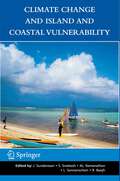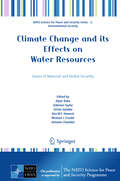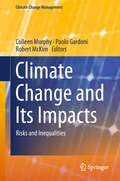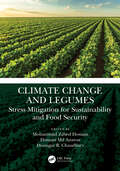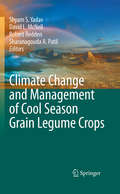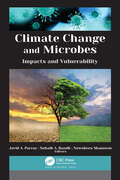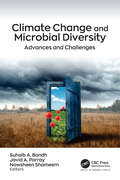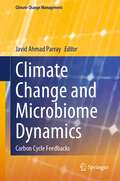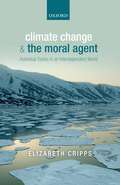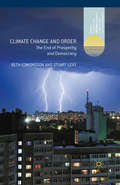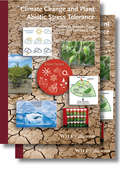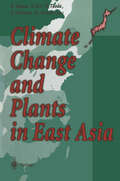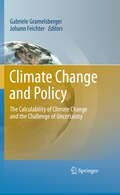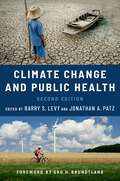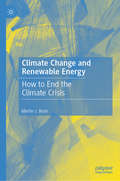- Table View
- List View
Climate Change and Island and Coastal Vulnerability
by J. Sundaresan S. Sreekesh A. L. Ramanathan Leonard Sonnenschein Ram Boojh"Climate Change and Island and Coastal Vulnerability” is the outcome of a selection of peer reviewed edited papers presented at the International Workshop on Climate Change and Island Vulnerability (IWCCI) held at Kadmat Island, Lakshadweep, India in October 2010. Marine and coastal biodiversity, sea level rise vulnerability, fisheries, climate change impact on livelihood options, water and sanitation in island ecosystem and mitigation, adaptation and governance are the focal themes. The basic concept conveyed in the book is that biodiversity of islands is to be protected as a natural mechanism to mitigate climate change. Probability recurrence of mass coral bleaching and the management of coral reefs and their future protection are discussed in this book. Marine productivity and climate change for the last ten thousand years in the Arabian Sea have been examined with core records. Green technology is suggested as an important tool for mitigation and adaptation programmes in climate change. Measures taken to project biomass utilisation of islands as an energy source is delineated. Climate change may pose a potential threat on human health. Improved sanitation packages and models that are cost effective and environment-friendly for islands are uniquely presented in this book.
Climate Change and its Effects on Water Resources: Issues of National and Global Security (NATO Science for Peace and Security Series C: Environmental Security)
by Alper Baba, Gökmen Tayfur, Orhan J. Gündüz, Ken W.F. Howard, Michael J. W. F. Friedel and Antonio ChambelNational and global security can be assessed in many ways but one underlying factor for all humanity is access to reliable sources of water for drinking, sanitation, food production and manufacturing industry. In many parts of the world, population growth and an escalating demand for water already threaten the sustainable management of available water supplies. Global warming, climate change and rising sea level are expected to intensify the resource sustainability issue in many water-stressed regions of the world by reducing the annual supply of renewable fresh water and promoting the intrusion of saline water into aquifers along sea coasts, where 50% of the global population reside. Pro-active resource management decisions are required, but such efforts would be futile unless reliable predictions can be made about the impact of the changing global conditions on the water cycle and the quality and availability of critical water reserves. Addressing this wide spectrum of issues, a team of expert authors discusses here the impacts of climate change on the global water resources, the long-term resource management goals at global and local scales, the data requirements and the scientific and technical advances necessary to mitigate the associated impacts.
Climate Change and Its Impacts: Risks and Inequalities (Climate Change Management)
by Colleen Murphy Paolo Gardoni Robert McKimResponding to a need for a deeper and more nuanced understanding of the consequences of climate change, this book brings experts in climate science, engineering, urban planning, and conservation biology into conversation with scholars in law, geography, anthropology and ethics. It provides insights into how climate change is conceptualized in different fields. The book also aims to contribute to developing successful and multifaceted strategies that promote global, intergenerational and environmental justice. Among the topics addressed are the effects of climate change on the likelihood and magnitude of natural hazards, an assessment of civil infrastructure vulnerabilities, resilience assessment for coastal communities, an ethical framework to evaluate behavior that contributes to climate change, as well as policies and cultural shifts that might help humanity to respond adequately to climate change.
Climate Change and Legumes: Stress Mitigation for Sustainability and Food Security
by Mohammad Zabed Hossain Hossain Anawar Doongar R. ChaudharyGlobal climate change has created unprecedented challenges for human civilization due to its widespread adverse consequences, including a reduction in crop yield and threatening food security across the globe. Among the crop plants, legumes have great potential for ameliorating global warming since they can reduce carbon emissions by lowering reliance on the application of chemical fertilizers, by increasing nitrification and carbon sequestration in soil, and by providing protein-rich diets to both humans and livestock. This book identifies the extent of climate-induced stresses on legume plants and focuses on achieving food security through sustainable agricultural practices.This book compiles recent research findings and reviews on climate-related problems, the potential of legumes in ameliorating the impacts of climate change, as well as better management of agricultural land and practices for achieving environmental sustainability and food security.This book will serve as guidelines for scientists, agricultural practitioners, and policymakers working to achieve food security and better management of climate-induced stresses in agricultural interventions. It will also be useful as a reference book for researchers and students of both graduate and postgraduate levels. Furthermore, this book will provide enhanced knowledge about the mechanisms of yield and stress tolerance of legumes as well as developing climate-smart crops and improving cropping systems for a sustainable environment and food security. Features of the book Reviews trends of global climate change and its consequences for food security across the continents Identifies the challenges and scopes of cultivating legumes in achieving food security in the context of global climate change Focuses on the improvements of legume production through conservation approaches in agricultural practices and modern techniques, including omics-based breeding, biotechnology, genetic engineering, and rhizobium technology Discusses the sustainable amelioration options for soils affected by climate-induced stresses Cites examples of applications of rhizobium technologies in reducing greenhouse gas emission Describes pathways associated with yield, resistance, and tolerance of legumes to climate-induced stresses
Climate Change and Legumes: Stress Mitigation for Sustainability and Food Security
Global climate change has created unprecedented challenges for human civilization due to its widespread adverse consequences, including a reduction in crop yield and threatening food security across the globe. Among the crop plants, legumes have great potential for ameliorating global warming since they can reduce carbon emissions by lowering reliance on the application of chemical fertilizers, by increasing nitrification and carbon sequestration in soil, and by providing protein-rich diets to both humans and livestock. This book identifies the extent of climate-induced stresses on legume plants and focuses on achieving food security through sustainable agricultural practices.This book compiles recent research findings and reviews on climate-related problems, the potential of legumes in ameliorating the impacts of climate change, as well as better management of agricultural land and practices for achieving environmental sustainability and food security.This book will serve as guidelines for scientists, agricultural practitioners, and policymakers working to achieve food security and better management of climate-induced stresses in agricultural interventions. It will also be useful as a reference book for researchers and students of both graduate and postgraduate levels. Furthermore, this book will provide enhanced knowledge about the mechanisms of yield and stress tolerance of legumes as well as developing climate-smart crops and improving cropping systems for a sustainable environment and food security. Features of the book Reviews trends of global climate change and its consequences for food security across the continents Identifies the challenges and scopes of cultivating legumes in achieving food security in the context of global climate change Focuses on the improvements of legume production through conservation approaches in agricultural practices and modern techniques, including omics-based breeding, biotechnology, genetic engineering, and rhizobium technology Discusses the sustainable amelioration options for soils affected by climate-induced stresses Cites examples of applications of rhizobium technologies in reducing greenhouse gas emission Describes pathways associated with yield, resistance, and tolerance of legumes to climate-induced stresses
Climate Change and Management of Cool Season Grain Legume Crops
by Shyam Singh Yadav Robert ReddenThis book covers all aspect of legume production management technologies, plant ecological response, nutrients management, biological nitrogen fixation, molecular approaches, potential cultivars, biodiversity management under climate change. Also covered are various aspects of legume management under climate change such as, production management technology, ecology & adaptation, diseases, and international trade; physiology and crops response to nutrients, drought, salinity, and water use efficiency; Biodiversity management, molecular approaches and biological Nitrogen fixation; climate change and strategies. This book presents the most comprehensive and up to date review of research on different cool season grain legume crops, nutrients management, biotic and abiotic stresses management, agronomical approaches for drought management, salinity, drought, weed management and water use efficiency, impact on international trade around the world.
Climate Change and Microbes: Impacts and Vulnerability
by Javid A. ParrayThis book provides an enlightening picture of the role of microbes for sustaining life systems and how climatic factors will change the course of the processes. Climate Change and Microbes: Impacts and Vulnerability explores the little-addressed issue of the effects of climate change on microbial ecosystems and the influence of climate change on microbiome diversity across various habitats and regions. Recent years have seen the evidence that microbial communities are neither immune to disruption nor do they have the capacity to recover completely after a stressful climate event. This volume documents the important role of microorganisms as climate engineers and considers mitigation and adaptation strategies as well. It goes on to present the research that addresses a diverse array of topics on the impact of climate change on plant-microbe interactions and microbial aquatic life and change-induced aggravations in microbial populations and processes. The book also addresses microbial foodborne diseases resulting from challenging climates. Other topics include algae as indicators of climate change and strategies for facilitating sustainable agro-ecosystems. This book will be immensely helpful in the study of plant microbiology, agricultural sciences, biotechnology, climate science, and environmental microbiology. It will also be applicable to the field of microbial biotechnology, agricultural, and other life and environmental sciences.
Climate Change and Microbes: Impacts and Vulnerability
by Javid A. Parray Suhaib A. Bandh Nowsheen ShameemThis book provides an enlightening picture of the role of microbes for sustaining life systems and how climatic factors will change the course of the processes. Climate Change and Microbes: Impacts and Vulnerability explores the little-addressed issue of the effects of climate change on microbial ecosystems and the influence of climate change on microbiome diversity across various habitats and regions. Recent years have seen the evidence that microbial communities are neither immune to disruption nor do they have the capacity to recover completely after a stressful climate event. This volume documents the important role of microorganisms as climate engineers and considers mitigation and adaptation strategies as well. It goes on to present the research that addresses a diverse array of topics on the impact of climate change on plant-microbe interactions and microbial aquatic life and change-induced aggravations in microbial populations and processes. The book also addresses microbial foodborne diseases resulting from challenging climates. Other topics include algae as indicators of climate change and strategies for facilitating sustainable agro-ecosystems. This book will be immensely helpful in the study of plant microbiology, agricultural sciences, biotechnology, climate science, and environmental microbiology. It will also be applicable to the field of microbial biotechnology, agricultural, and other life and environmental sciences.
Climate Change and Microbial Diversity: Advances and Challenges
by Suhaib A. Bandh Javid A. Parray Nowsheen ShameemThe ongoing global climate change triggered by greenhouse gas growth has had a significant effect on the microbial dynamics of plants and soils. This volume explores the various microbial responses of plants and soils caused directly or indirectly by climate change resulting from rising greenhouse gases and other factors. The book considers the rapidly changing environment and the important role of microbiomes in restoring soil and plant health and in creating sustainable approaches. It discusses the adaptation and mitigation of plants and soils, specifically addressing such topics as biogeochemical processes, antimicrobial resistance, the dynamics of bacteria and fungus in extreme environments, bacterial siderophores for sustainability, and more. The volume also looks at edaphic and regeneration performance of tree species in the temperate forests.
Climate Change and Microbial Diversity: Advances and Challenges
by Suhaib A. Bandh, Javid A. Parray and Nowsheen ShameemThe ongoing global climate change triggered by greenhouse gas growth has had a significant effect on the microbial dynamics of plants and soils. This volume explores the various microbial responses of plants and soils caused directly or indirectly by climate change resulting from rising greenhouse gases and other factors. The book considers the rapidly changing environment and the important role of microbiomes in restoring soil and plant health and in creating sustainable approaches. It discusses the adaptation and mitigation of plants and soils, specifically addressing such topics as biogeochemical processes, antimicrobial resistance, the dynamics of bacteria and fungus in extreme environments, bacterial siderophores for sustainability, and more. The volume also looks at edaphic and regeneration performance of tree species in the temperate forests.
Climate Change and Microbiome Dynamics: Carbon Cycle Feedbacks (Climate Change Management)
by Javid Ahmad ParrayThe book provides an overview relevant to various biological mechanisms that regulate carbon exchanges between the major components and their response to climate change. Climate change has a significant impact on people's lives, energy demand, food security, etc. The soil microbial ecology is vital for assessing terrestrial and aquatic carbon cycles and climate feedback. However, the primary concern is the complexity of the soil microbial community and its severely affected functions due to the climate and other global changes. Global warming comprises an assessment of the dynamic interactions and feedback between microbes, plants, and their physical environment due to climate change. The book will address the need to use a multifactor experimental approach to understand how soil microorganisms and their activities adapt to climate change and the implications of carbon cycle feedback. The most pressing concern is a clearer understanding of the biological factors that regulate carbon exchanges between land, oceans, and the atmosphere and how these exchanges will respond to climate change via climate–ecosystem feedbacks, which could augment or quell regional and global climate change. Terrestrial ecosystems play an important role in climate feedback as they produce and absorb greenhouse gases like carbon dioxide, methane, and nitrous oxides. They also strongly contribute to storing enormous amounts of carbon in living vegetation and soils, rendering them a significant global carbon sink. If climate change projections are realistic, such a rapid increase in carbon loss from soil could exacerbate the soil carbon cycle feedback. The book will determine the role of microbial feedback in regulating soil-land-atmosphere carbon exchange under changing climatic conditions at the regional and global levels. The current book will also focus on recent research designed to use beneficial microbes such as plant growth-promoting microorganisms, fungi, endophytic microbes, and others to improve understanding of the interaction and their potential role in promoting advanced management for sustainable agricultural solutions. Understanding the influence on the native microbiome, such as the distribution of methanogens and methanotrophs, nutritional content, microbial biomass, and other factors, is becoming increasingly crucial to establishing climate-resilient agriculture.
Climate Change And The Moral Agent: Individual Duties In An Interdependent World
by Elizabeth CrippsMany of us take it for granted that we ought to cooperate to tackle climate change. But where does this requirement come from and what does it mean for us as individuals trying to do the right thing? Although climate change does untold harm to our fellow humans and to the non-human world, no one causes it on their own and it is not the result of intentionally collective action. In the face of the current failure of institutions to confront the problem, is there anything we can do as individuals that will leave us able to live with ourselves? This book responds to these challenges. It makes a moral case for collective action on climate change by appealing to moralized collective self-interest, collective ability to aid, and an expanded understanding of collective responsibility for harm. It also argues that collective action is something we owe to ourselves, as moral agents, because without it we are left facing marring choices. In the absence of collective action, individuals should focus on trying to promote such action (whether through or by bypassing existing institutions), with a supplementary duty to aid victims directly. The argument is not that we should not be cutting our own emissionsthis can be a vital part of bringing about collective action or alleviating harmbut that such `green lifestyle choices cannot straightforwardly be defended as duties in their own right, and should not take priority over trying to bring about collective change.
Climate Change and Natural Disasters: Transforming Economies and Policies for a Sustainable Future
by Vinod ThomasThe Open Access version of this book, available at https://www.taylorfrancis.com/books/9781351527927, has been made available under a Creative Commons Attribution-Non Commercial-No Derivatives 4.0 license The start of the new millennium will be remembered for deadly climate-related disasters - the great floods in Thailand in 2011, Super Storm Sandy in the United States in 2012, and Typhoon Haiyan in the Philippines in 2013, to name a few. In 2014, 17.5 million people were displaced by climate-related disasters, ten times more than the 1.7 million displaced by geophysical hazards. What is causing the increase in natural disasters and what effect does it have on the economy? Climate Change and Natural Disasters sends three messages: human-made factors exert a growing influence on climate-related disasters; because of the link to anthropogenic factors, there is a pressing need for climate mitigation; and prevention, including climate adaptation, ought not to be viewed as a cost to economic growth but as an investment. Ultimately, attention to climate-related disasters, arguably the most tangible manifestation of global warming, may help mobilize broader climate action. It can also be instrumental in transitioning to a path of low-carbon, green growth, improving disaster resilience, improving natural resource use, and caring for the urban environment. Vinod Thomas proposes that economic growth will become sustainable only if governments, political actors, and local communities combine natural disaster prevention and controlling climate change into national growth strategies. When considering all types of capital, particularly human capital, climate action can drive economic growth, rather than hinder it.
Climate Change and Natural Disasters: Transforming Economies and Policies for a Sustainable Future
by Vinod ThomasThe Open Access version of this book, available at https://www.taylorfrancis.com/books/9781351527927, has been made available under a Creative Commons Attribution-Non Commercial-No Derivatives 4.0 license The start of the new millennium will be remembered for deadly climate-related disasters - the great floods in Thailand in 2011, Super Storm Sandy in the United States in 2012, and Typhoon Haiyan in the Philippines in 2013, to name a few. In 2014, 17.5 million people were displaced by climate-related disasters, ten times more than the 1.7 million displaced by geophysical hazards. What is causing the increase in natural disasters and what effect does it have on the economy? Climate Change and Natural Disasters sends three messages: human-made factors exert a growing influence on climate-related disasters; because of the link to anthropogenic factors, there is a pressing need for climate mitigation; and prevention, including climate adaptation, ought not to be viewed as a cost to economic growth but as an investment. Ultimately, attention to climate-related disasters, arguably the most tangible manifestation of global warming, may help mobilize broader climate action. It can also be instrumental in transitioning to a path of low-carbon, green growth, improving disaster resilience, improving natural resource use, and caring for the urban environment. Vinod Thomas proposes that economic growth will become sustainable only if governments, political actors, and local communities combine natural disaster prevention and controlling climate change into national growth strategies. When considering all types of capital, particularly human capital, climate action can drive economic growth, rather than hinder it.
Climate Change and Order: The End of Prosperity and Democracy (Energy, Climate and the Environment)
by Beth Edmondson Stuart LevyBeth Edmondson and Stuart Levy examine why it is so difficult for the international community to respond to global climate change. In doing so, they analyse and explain some of the strategies that might ultimately provide the foundations for appropriate responses.
Climate Change and Plant Abiotic Stress Tolerance
by Narendra Tuteja Sarvajeet S. GillIn this ready reference, a global team of experts comprehensively cover molecular and cell biology-based approaches to the impact of increasing global temperatures on crop productivity. The work is divided into four parts. Following an introduction to the general challenges for agriculture around the globe due to climate change, part two discusses how the resulting increase of abiotic stress factors can be dealt with. The third part then outlines the different strategies and approaches to address the challenge of climate change, and the whole is rounded off by a number of specific examples of improvements to crop productivity. With its forward-looking focus on solutions, this book is an indispensable help for the agro-industry, policy makers and academia.
Climate Change and Plant Abiotic Stress Tolerance
by Narendra Tuteja Sarvajeet S. GillIn this ready reference, a global team of experts comprehensively cover molecular and cell biology-based approaches to the impact of increasing global temperatures on crop productivity. The work is divided into four parts. Following an introduction to the general challenges for agriculture around the globe due to climate change, part two discusses how the resulting increase of abiotic stress factors can be dealt with. The third part then outlines the different strategies and approaches to address the challenge of climate change, and the whole is rounded off by a number of specific examples of improvements to crop productivity. With its forward-looking focus on solutions, this book is an indispensable help for the agro-industry, policy makers and academia.
Climate Change and Plants in East Asia
by Kenji Omasa Keiko Kai Hiroshi Taoda Zenbei Uchijima Masatoshi YoshinoEast Asia, with its large, fast-growing population and rapid industrialization, is an important area for global environmental problems, both in terms of the generation of greenhouse gases and the effects of any change in crop yields. The probable climate changes caused by increased concentrations of greenhouse gases and the modeling of plant production, vegetation distribution, phenological events, and lake ecosystems are discussed in this book. Besides providing an overview and synthesis of recent research, this volume shows the importance of analyzing local field data on microclimates, soil environments, the extent of snow cover, and the productivity of mountain vegetation. The possible effects of increasing concentrations of carbon dioxide and rising temperatures on rice yield are shown from controlled environment experiments. This book will be particularly valuable to researchers and students in the fields of ecology, crop science, forestry, and environmental sciences as well as being of interest to anyone concerned with global environmental problems.
Climate Change and Policy: The Calculability of Climate Change and the Challenge of Uncertainty
by Gabriele Gramelsberger and Johann FeichterThe debate on how mankind should respond to climate change is diverse, as the appropriate strategy depends on global as well as local circumstances.As scientists are denied the possibility of conducting experiments with the real climate, only climate models can give insights into man-induced climate change, by experimenting with digital climates under varying conditions and by extrapolating past and future states into the future. But the ‘nature’ of models is a purely representational one. A model is good if it is believed to represent the relevant processes of a natural system well. However, a model and its results, in particular in the case of climate models which interconnect countless hypotheses, is only to some extent testable, although an advanced infrastructure of evaluation strategies has been developed involving strategies of model intercomparison, ensemble prognoses, uncertainty metrics on the system and component levels. The complexity of climate models goes hand in hand with uncertainties, but uncertainty is in conflict with socio-political expectations. However, certain predictions belong to the realm of desires and ideals rather than to applied science. Today’s attempt to define and classify uncertainty in terms of likelihood and confidence reflect this awareness of uncertainty as an integral part of human knowledge, in particular on knowledge about possible future developments. The contributions in this book give a first hand insight into scientific strategies in dealing with uncertainty by using simulation models and into social, political and economical requirements in future projections on climate change. Do these strategies and requirements meet each other or fail?The debate on how mankind should respond to climate change is diverse, as the appropriate strategy depends on global as well as local circumstances. As scientists are denied the possibility of conducting experiments with the real climate, only climate models can give insights into man-induced climate change, by experimenting with digital climates under varying conditions and by extrapolating past and future states into the future. But the 'nature' of models is a purely representational one. A model is good if it is believed to represent the relevant processes of a natural system well. However, a model and its results, in particular in the case of climate models which interconnect countless hypotheses, is only to some extent testable, although an advanced infrastructure of evaluation strategies has been developed involving strategies of model intercomparison, ensemble prognoses, uncertainty metrics on the system and component levels. The complexity of climate models goes hand in hand with uncertainties, but uncertainty is in conflict with socio-political expectations. However, certain predictions belong to the realm of desires and ideals rather than to applied science. Today's attempt to define and classify uncertainty in terms of likelihood and confidence reflect this awareness of uncertainty as an integral part of human knowledge, in particular on knowledge about possible future developments. The contributions in this book give a first hand insight into scientific strategies in dealing with uncertainty by using simulation models and into social, political and economical requirements in future projections on climate change. Do these strategies and requirements meet each other or fail? Gabriele Gramelsberger is Principal Investigator of the Collaborative Research Project is Principal Investigator of the Collaborative Research Project
Climate Change and Public Health
by Barry S. LevyThis second edition of Climate Change and Public Health comprehensively covers the health impacts of climate change, including heat-related and respiratory disorders, vectorborne and waterborne diseases, malnutrition, mental disorders, and violence. It provides a thorough understanding of the policymaking process and energy, transportation, and agriculture policies for mitigation. It covers health adaptation, sustainable built environments, and nature-based solutions to address climate change. Finally, it describes ways of strengthening public and political support, including communicating the health relevance of climate change, building movements, and promoting climate justice.
Climate Change and Public Health
This second edition of Climate Change and Public Health comprehensively covers the health impacts of climate change, including heat-related and respiratory disorders, vectorborne and waterborne diseases, malnutrition, mental disorders, and violence. It provides a thorough understanding of the policymaking process and energy, transportation, and agriculture policies for mitigation. It covers health adaptation, sustainable built environments, and nature-based solutions to address climate change. Finally, it describes ways of strengthening public and political support, including communicating the health relevance of climate change, building movements, and promoting climate justice.
Climate Change and Regional Socio-Economic Systems in the Global South: Resilience Strategies for Sustainable Development
by Mukunda Mishra Andrews José de Lucena Brij MaharajThis volume showcases how the climate change phenomena (CCP) have been causing multifaceted threats to humankind through increasing numbers of extreme events, affecting social, economic, and human development worldwide. The Global South is especially showcased in this contributory volume where adverse effects of CCP and related disasters impact majority of the population which depends on land and natural resources for their livelihoods. This book asserts that climate change and extreme events are potential threats to sustainable human development and micro spatial observations and analysis of impacts of CCP are vital for adopting resilience policies. This book, not enquiring why CCP is happening, embarks on a quest to showcase how best to respond to such phenomena through detailed and well-founded micro-spatial investigations on poor farmers, pastoralists, fishermen folk, migrant labours, slum dwellers, who are considered the most threatened by climate changes and weather shocks, based on possible disruptions in the production process. Scholarly contributions in this volume analyze how local and regional versions of CCP actively challenge the economies and livelihoods, question the social securities and good governance, and how such phenomena ultimately become a constraint in achieving sustainable development in the Global South. This volume accommodates many aspects of regional adaptation strategies in vulnerable areas and groups in different parts of the Global South to ensure stability and peacefulness. Academicians, research scholars, and readers inquisitive about the socio-economic dimensions of climate change in the Global South, will find the discussions across different chapters of this volume interesting.
Climate Change and Renewable Energy: How to End the Climate Crisis
by Martin J. BushThis book presents a comprehensive overview of the global climate change impacts caused by the continued use of fossil fuels, which results in enormous damage to the global environment, biodiversity, and human health. It argues that the key to a transition to a low carbon future is the rapid and large-scale deployment of renewable energy technologies in power generation, transport and industry, coupled with super energy-efficient building design and construction. However, the author also reveals how major oil companies and petrochemical conglomerates have systematically attempted to manufacture doubt and uncertainty about global warming and climate change, continue to block the commercialization of solar energy and wind power, and impede the electrification of the transport sector. Martin Bush’s solution is a theory-of-change approach to substantially reduce greenhouse-gas emissions by 2050, which sets out realistic steps that people can take now to help make a difference.
Climate Change and Risk in South and Southeast Asia: Sociopolitical Perspectives (Routledge Studies in Hazards, Disaster Risk and Climate Change)
by Devendraraj Madhanagopal Salim MomtazThis book, focuses on South and Southeast Asia, upgrades our understanding of the influence of multiple sociopolitical and governance factors on climate change and risks. Moving beyond science and technology-oriented discussions on climate change, it argues that the real solutions to climate change problems lie in societies, governance systems, non-state actors, and the power and politics underpinning these systems. It presents a range of detailed conceptual, empirical, and policy-oriented insights from different nations of South and Southeast Asia, including India, Bangladesh, Sri Lanka, Indonesia, Vietnam, Maldives, and Bhutan. The chapters bring forth critical discussions of climate change, covering a diverse range of topics including livelihoods, gender, community perspectives, relocation, resilience, local politics, climate change communication, governance, and policy responses. By investigating climate change vulnerabilities and as well as offering feasible solutions to the states and other non-state actors in responding to climate change and risks, this book deepens our existing knowledge of the social and political dimensions of climate change. With interdisciplinary perspectives, this book will appeal to all students, researchers, and scholars of environmental studies, geography, disaster studies, sociology, policy studies, development studies, and political science. It provides valuable reading to practitioners, policymakers, and professionals working in related fields.
Climate Change and Risk in South and Southeast Asia: Sociopolitical Perspectives (Routledge Studies in Hazards, Disaster Risk and Climate Change)
by Devendraraj Madhanagopal Salim MomtazThis book, focuses on South and Southeast Asia, upgrades our understanding of the influence of multiple sociopolitical and governance factors on climate change and risks. Moving beyond science and technology-oriented discussions on climate change, it argues that the real solutions to climate change problems lie in societies, governance systems, non-state actors, and the power and politics underpinning these systems. It presents a range of detailed conceptual, empirical, and policy-oriented insights from different nations of South and Southeast Asia, including India, Bangladesh, Sri Lanka, Indonesia, Vietnam, Maldives, and Bhutan. The chapters bring forth critical discussions of climate change, covering a diverse range of topics including livelihoods, gender, community perspectives, relocation, resilience, local politics, climate change communication, governance, and policy responses. By investigating climate change vulnerabilities and as well as offering feasible solutions to the states and other non-state actors in responding to climate change and risks, this book deepens our existing knowledge of the social and political dimensions of climate change. With interdisciplinary perspectives, this book will appeal to all students, researchers, and scholars of environmental studies, geography, disaster studies, sociology, policy studies, development studies, and political science. It provides valuable reading to practitioners, policymakers, and professionals working in related fields.
